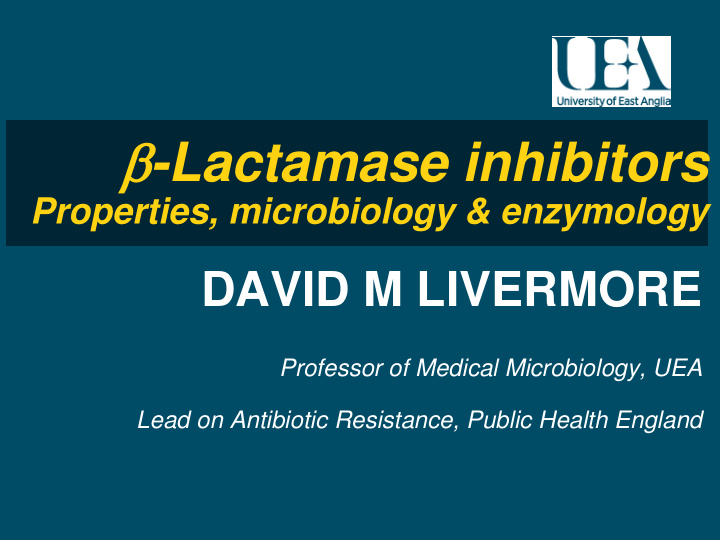



β -Lactamase inhibitors Properties, microbiology & enzymology DAVID M LIVERMORE Professor of Medical Microbiology, UEA Lead on Antibiotic Resistance, Public Health England
β -Lactamase classes Serine at active site--- A Diverse… TEM, SHV, CTX-M, KPC etc Zinc at active site, VIM, NDM etc B Serine at active site--- AmpC cephalosporinases C Serine at active site– OXA types--- diverse D
Successive β -lactamase challenges From Enzyme(s) Class Compromised 1940s Staph penicillinase A Penicillin 1960s TEM-1 penicillinase in G -ves A Ampicillin 1960s Inherent R, Klebsiella, Enterobacter , A,C Amp/ 1-gen cephs 1970s High level AmpC, Enterobacter etc. C 2/3-gen cephs 1980s TEM/SHV, ESBLs in G-ves A 2/3 gen cephs 2000s CTX-M ESBLs A 2/3 gen cephs 2000s Acinetobacter carbapenemases D Carbapenems 2010s Enterobacterial carbapenemases A,B,D Carbapenems/All Increasingly…..Gram –ves have multiple β -lactamases
Determinants of activity of inhibitor combinations • Type of β -lactamase Mutations can change affinity for inhibitor or substrate • Partner β -lactam • Amount of β -lactamase • Target organism • pH Livermore JAC 1993; 31 Suppl A :9
What inhibits which β - lactamase? Clav- Tazo- Avi- EDTA ulanate bactam bactam Maleic acids ESBL +++ ++ +++ - KPC Yes, but also hydrolysed ++ - AmpC - + +++ - OXA-1 + + ? - OXA-48 - - + - OXA-23 - - - - MBLs - - - ++ Some boronates may inhibit all
Resistance to clavulanate & sulphone inhibitor combinations • Mutations reduce binding of clavulanate & sulphones TEM-31 (IRT-1) Arg244Ser TEM-30 (IRT-2) Arg244Cys • Resistance mutants occur, selection in therapy rare Canton et al., CMI 2008; 14 Suppl 1: 53 Livermore JAC 1993; 31 Suppl A :9
MICs (mg/L) for CAZ-AVI-selected bla KPC mutants: CAZ-AVI CAZ-AVI Ceftaroline Single & multi-step 1 mg/L 4 mg/L –AVI 4 mg/L mutants (X+Y) Parent Mutants Parent Mutants Parent Mutants Klebsiella NCTC13438 (29+2) 8 64->256 1 4-128 0.5 0.5-8 H…643 (24+6) 8 32->256 1 8-128 1 0.5-4 Enterobacter H…226 (28+5) 1 16-256 0.5 4-128 0.5 1-8 H…216 (7+0) 1 16-128 0.25 8-64 0.5 0.5-2 Geom. mean rise, 30.5-fold 34.3-fold 3.3-fold Mutants (101) pooled Livermore et al . AAC 2015; 59: 5324
KPC sequences from 13 CAZ-AVI- selected mutants Klebsiella Klebsiella E cloacae E cloacae NCTC 13438 H…643 H…226 H…216 Asp163Gly 1 Pro174Leu 1 1 Asp179Tyr 2 1 1 180Ser181 1 181 Ser-Ser 182 1 183 Arg-Ala-Val-Thr- 1 Thr-Ser-Ser-Pro 184 Thr243Pro 1 265Ala-Arg 266 1 None 1 Livermore et al . AAC 2015; 59: 5324
Why are some β -lactams easier to protect? • Weaker substrate / lower affinity (=higher K m ) • High affinity partner β -lactam may protect the enzyme • Fewer enzymes need to be inhibited if drug is stable to some Many isolates now have multiple β -lactamases Can overcome multiple enzyme if partner is stable to some and inhibitor inactivates others
Activity of co-amoxiclav 2:1 vs. ESBL +ve E. coli & Klebsiella 300 250 E. coli 200 Klebsiella 150 100 50 0 2 4 8 16 32 >=64 MIC, mg/L Livermore et al. CMI 2008; 14 Suppl 1: 189
Cefepime-clavulanate (4 mg/L) vs. ESBL E. coli Livermore et al. CMI 2008; 14 Suppl 1: 189
Carbapenems + ME1071 vs. 20 NDM Enterobacteriaceae Geom. mean MIC (mg/L) k cat (s -1 ) K m ( µ M) Alone +128 mg/L ME1071 Imipenem 315 60 42.2 10.6 Meropenem 77 15 84.5 19.0 Doripenem 275 41 68.6 10.9 Biapenem 233 314 7.7 0.78 Livermore et al JAC 2013; 68 :153
Aztreonam-avibactam aztreonam is stable to MBLs anyway…. Livermore et al. AAC 2011; 55: 390–394
Potentiation in relation to amount of TEM-1 β -lactamase Quartile of β -lactamase distribution 1 2 3 4 Geom. mean [inhibitor] to bring amoxicillin MIC to <8 mg/L Tazobactam 1.6 1.7 4.7 14.9 Geom. mean [inhibitor] to bring piperacillin MIC to <16 mg/L Tazobactam 1.3 1.3 2.7 5.4 Livermore & Seetulsingh, JAC 1991; 27 : 761
Pip/tazo vs. K. pneumoniae PN1 clone SHV-4 Count 5 isolates also had TEM-1 MIC (mg/L) Babini et al. JAC 2003; 51 :605
Pip/tazo MICs & SHV-4 activity in K25/PN1 isolates >1024 512 256 Pip/taz MIC (mg/L) 128 64 32 16 8 4 2 1 0 20 40 60 80 100 nmoles cefotaxime hydrolysed/min/mg protein
Pip-tazo vs. E. coli and P. aeruginosa with PR4 plasmid / TEM-2 10000 MIC piperacillin (mg/L) E. coli J53-1 1000 P. aeruginosa PU21 100 10 1 0 1 2 4 8 16 32 [Tazobactam] mg/L Livermore JAC 1993; 31 Suppl A :9
pH, TEM-1 & piperacillin- tazobactam…. I 50 (10 min) µ M pH V max /K m MIC (mg/L) E. coli K-12 R - Clav Tazo Pip TEM-1 TEM-1 pip pip-tazo pip-clav 6.5 0.22 1.1 0.45 1 64 4 7.0 0.29 0.51 0.25 1 4 2 7.5 0.27 0.15 0.25 0.5 2 1 8.0 0.13 0.008 0.17 0.5 1 0.5 Livermore & Corkill AAC 1992; 36: 1870
Summary • Activity of inhibitor combinations reflects: Enzyme type….Amount…..Partner ….Organism…..pH • Long history of sub-optimal combinations Who owns what; what’s out of patent / known / safe • Need to simply dev’t of better combinations If β -lactam A is available with inhibitor I & β -lactam B with inhibitor II Trials should be simplified for A+II
Recommend
More recommend